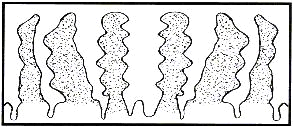
Celiac disease is a disease that mainly affects the small intestine. It is an intolerance to gluten, a protein found in wheat, rye, barley, oats and malt. Celiac disease is considered an autoimmune disorder, in which the body attacks itself.
It generally appears in childhood, in the first three years of life, when cereals are introduced into the diet, although it can also appear in adulthood.
When ingested, the gluten reaches the intestine and stimulates the production of antibodies. They act on the villi of the intestine, which atrophy and no longer perform the function of capturing nutrients. As a result, unabsorbed nutrients are eliminated with feces, and the body is deprived of basic nutrients, becoming malnourished over time.
 Mucosa of the small intestine with normal villi
Mucosa of the small intestine with normal villi
 Mucosa of the small intestine with atrophied villi
Mucosa of the small intestine with atrophied villi
Symptoms
Symptoms include chronic diarrhea or constipation, bloating and flatulence, irritability, and poor weight gain. Celiac disease may also not present any symptoms.
A
Diagnosis
Celiac disease can take years to diagnose. Blood tests are widely used to detect celiac disease. Celiac disease must be confirmed by finding certain changes in the villi lining the wall of the small intestine. To see these changes, a tissue sample from the small intestine is taken through a procedure called biopsy endoscopy.
Treatment
Treatment consists of avoiding foods that contain gluten for life (breads, cereals, cakes, pizzas, and other food products, or additives, that contain wheat, rye, oats and barley). may contain gluten. It should always be noted on the packaging that the ingredients contain the following warning: Contains Gluten.
It is possible to replace the flours that should be avoided with potato starch, corn flour, corn starch, sweet or sour tapioca flour, rice flour or cream, arrowroot flour or cornmeal.
In this link, you can find a list of prohibited and permitted foods.
Patients may begin to show improvement 1 or 2 weeks after starting the diet. Lactose intolerance caused by intestinal damage also decreases. In most people, symptoms disappear and the intestinal wall fully recovers 6 to 12 months after starting the gluten-free diet.
Gluten-free recipes
Gluten-Free Potato Bread
Ingredients
- 2 large potatoes,
- 2 tablespoons of margarine,
- Â 1 tablet of organic yeast,
- 2 eggs,
- half a cup of warm water,
- 4 tablespoons of soy milk powder,
- 2 cups of cornstarch,
- 1 cup of potato starch,
- 1 level tablespoon of salt.
A
Method of preparation
Cook the potatoes without salt, mash them and let them cool. Blend the margarine, yeast, eggs and warm water in a blender. In a bowl, mix the flour, powdered milk and salt. Place what was blended in the blender and the cooked potato over the flour mixture. Mix well until it becomes a homogeneous mass. Place on a greased loaf pan, wait for it to rise (approximately 1 hour) and bake in the oven at 230 degrees until a toothpick inserted comes out clean (approximately 40 minutes).
Chicken Pie With Vegetables
Ingredients
Pasta:
- 4 eggs
- 1/2 cup of oil
- 1/2 cup of milk
- 2 cups of rice flour
- salt to taste
Filling:
- 1 cooked and shredded chicken breast
- 3 carrots cut into cubes
- 2 chayotes cut into cubes
- 2 chopped tomatoes
- 2 chopped onions
- Chopped parsley and chives
- salt
Preparation
Filling: Sauté the onion, add the tomatoes, seasonings, vegetables, shredded chicken and cook until everything is soft and set aside.
Dough: Blend the ingredients in a blender. Place half of the dough in a greased pan sprinkled with rice flour. Spread the filling, add the rest of the dough and place in the oven to bake.
Sponge cake filled with Creamy Dulce de Leche and covered with sugar syrup.
Ingredients
- 6 eggs
- 1 cup (tea) of sugar
- half a cup of milk
- 1 cup (tea) potato starch
- half a tablespoon of chemical baking powder
- 1 can of MOÇA® Creamy Dulce de Leche
- 2 cups of icing sugar
- half a cup of milk
- butter for greasing
- potato starch for sprinkling
Method of preparation
In a mixer, beat the eggs until they double in volume. Add the sugar and beat some more. Reduce the mixer speed and add the milk. Turn off and add the starch and yeast and mix gently. Pour into a rectangular pan (30x41cm), greased and sprinkled. Place in a preheated medium-high oven (200°C) for around 30 minutes. Remove from the oven and wait for it to cool. Unmold and cut the cake in half, into two halves (20x30cm). On one of the parts, spread the Dulce de Leche and cover with the other half. Mix the icing sugar with the milk and pour over the cake. Wait for it to dry and serve.
Source: http://www.doencaceliaca.com.br/doencaceliaca.htm
http://cyberdiet.terra.com.br/intolerancia-ao-gluten-5-1-4-304.html
http://www.acelbra.org.br/2004/doencaceliaca.php
http://www.acelbra.org.br/2004/receitas_sem_gluten.php
http://tvtem.globo.com/culinaria/receita.asp?EditoriaID=51&codigo=2364
http://www.riosemgluten.com/receitas.htm

